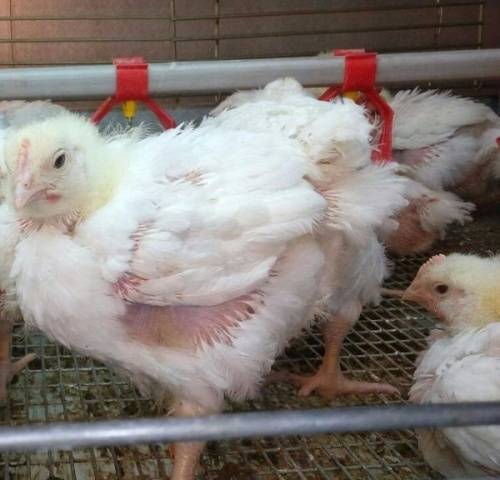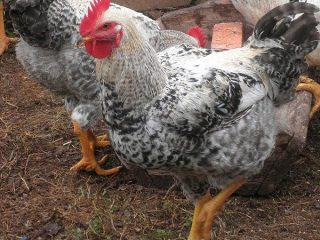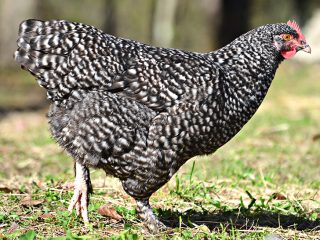Content
The current trend of urban residents to move to the countryside away from the bustle of the city and exhaust fumes and closer to fresh air and peace can only evoke positive emotions.
But townspeople who come to the village literally find themselves in a parallel world with many aspects unknown to city residents.
However, all village newcomers still remember what they read in a book or saw in a film, an obligatory attribute of village life - a chicken walking on the grass.
The settlers try to start their village life with chicken breeding. Although it would be more logical to have a supply of firewood for the winter.
Since the domestication of chickens, many breeds have been developed to suit every taste. It is not easy for a novice poultry farmer to decide which breed of chicken is best to buy for breeding. at home.
To understand your needs, you need to honestly answer several questions.
- Do I want to get eggs or meat from a chicken, or maybe both?
- Am I willing to spend money on an incubator and brooders?
- How do I plan to keep chickens: in an aviary, in cages or in the wild?
- What is the climate in my region?
- How easy is it to get specialized chicken feed?
To answer these questions, you first need to understand what the three large groups of chicken breeds are.
Group of chicken breeds for egg production
This includes all modern egg crosses, such as Hisex, Lohmann, Tetra, and some breeds of chickens that are the ancestors of industrial egg crosses, for example, Leghorn. These breeds of laying hens are demanding in terms of feed and living conditions. If the food is of poor quality, the temperature is inappropriate, or there is insufficient lighting, they stop laying eggs. But on the plus side, they have high stress resistance.
But the main problem with egg hens is that they have completely lost their brooding instinct.
Group of chicken breeds for meat production
Usually they are all called broilers. Although broilers also have their own “breeds,” including colored ones: COBB 500, ROSS-308, redbro, redpack.
Broiler breeds characterized by rapid weight gain. These chickens cannot be kept for longer than 3 months, not only because of a sharp drop in profitability, but after 3 months the broilers themselves become obese to such an extent that they are unable to move.
Broiler breeds are also very demanding in terms of housing conditions and feed.If you treat them like ordinary village chickens: let them out “on the grass to look for worms,” feed them regular feed, not food intended for broilers, keep them in a regular barn without observing the temperature regime, then the broilers will most likely survive , but will not grow.
Group of chicken breeds of a universal direction
These are precisely the breeds of chickens that produce offspring with the same qualities that the parents possessed. Unlike industrial crosses, from which in the second generation anything can turn out. In addition, being bred by folk selection methods or at breeding stations specifically for breeding by the population in private backyards, such breeds of chickens are much less demanding both in terms of feed and living conditions.
Beginning chicken breeders are better off choosing universal chicken breeds, preferably adapted to the appropriate region. Domestic breeds of universal chickens include Kuchinsky Jubilee chicken, Oryol chicken, Moscow White, Zagorsk salmon breed, Poltava clay chicken and so on. You can ask your neighbors what breed of chickens they prefer. True, most likely the answer will be: “outbred.”
When choosing a breed of universal chickens, you do not need to worry about a lack of eggs. These breeds of chickens lay eggs not much worse egg breeds. Village chicken owners complain that they have nowhere to put eggs from only 7 chickens. Overproduction. But these owners keep chickens exclusively for themselves.
So, in general, the decision of beginners to first acquire chickens is correct. And how difficult it is to raise chickens at home for beginners can be determined after reading the article.
Keeping and breeding chickens of any breed and any direction has a certain similarity: a warm room in winter, roosts, long daylight hours, vitamin and mineral supplements in feed.
Whether purebred or mongrel, chickens need a place to live, so creating conditions for keeping laying hens must begin with building a house for them.
Chicken coop structure
Build modern chickens chicken coops There is no particular need if cellular maintenance is not planned. Yes, and an ordinary shed can be adapted for cage keeping by installing exhaust ventilation and cages in it.
The main requirement when installing a chicken coop is the absence of drafts. Therefore, a chicken coop can be an ordinary barn with well-caulked cracks.
When keeping chickens on the floor in a barn, roosts are arranged at some distance from the floor. The perch should not be too close to the ceiling, otherwise the chicken will not be able to sit on it.
For chickens capable of taking off, perches are arranged as high as possible, but so that the chicken fits freely between the ceiling and the perch. For flightless birds, perches can be made at a height of up to 50 cm so that the chicken can jump on it. An ancient instinct forces chickens to imitate wild ancestors who spent the night in trees, so it is important for a chicken to feel a “tree branch” under its paws at night.
Chicken roosts can be made on several levels. You can use old wooden ladders attached at an angle to the wall of the chicken coop.
Sawdust or straw is poured onto the floor and cleaned periodically.
With such free housing, laying hens must be provided with “nests” into which they will lay eggs. Chickens are usually known for their consistency.Having chosen a place for oviposition, they lay all their eggs there. To guarantee, you don’t have to take all the eggs at once, but leave 2-3 in the nest, then the chicken will definitely return to this particular nest.
With such crowds, chickens often damage eggs laid earlier. Chickens eat cracked eggs, learning to peck and eat intact eggs. The second reason for eating eggs - lack of calcium - is eliminated by adding limestone to the feed.
Nest arrangement
Nests for laying hens are made either from individual boxes or from a common gutter. Straw is placed in the container so that the chickens can crush it into the shape of a nest. The straw must be changed as it becomes dirty, then the chickens will not go looking for another place to lay eggs.
Laying boxes can be regular vegetable containers or specially made boxes with a “roof” and an entrance open on the side.
It is possible to arrange cage keeping of chickens in the barn.
A creative solution for keeping chickens in cages, and more, in a barn can be seen in the video:
Dimensions of a chicken coop when keeping chickens in cages
The reason for the fights between turkey poults, unknown to the owner of this video, is crowded conditions. The stress of being in a cramped and low room results in fights. In chickens kept in cages and industrial floors, the behavior is similar. That's why chickens' beaks are trimmed in poultry farms.
And a much more civilized homemade chicken coop in the garage
Chicken coop in the garage with homemade cages
If chickens were bred not only for production, but also for the soul, the best option would be a barn with access to an aviary.
Feeding chickens
Depending on the choice of productive direction, chicken feed will vary slightly. Broiler breeds need protein and carbohydrates for weight gain, plus calcium for bone growth. They do not need to develop a reproductive system.
In addition to basic nutrients, laying hens and all-purpose breeds also require vitamin E.
If you plan to sell chicken eggs outside, you need to provide the chicken with additives for a bright yolk color.
The myth that eggs with a dark yellow yolk were laid by a chicken walking on the grass, and such an egg is healthier than an egg with a light yellow yolk, is ineradicable. And since it is indestructible, then it must be used.
Why do the yolks in eggs differ in color?
For comparison. Which egg is better? With orange yolk? In fact, there is not much difference. The color of the yolk depends on the feed that the laying hen was fed. With a high carotene content, even if it is an artificial ingredient, and the chicken has been living in a cage since birth and fed exclusively on mixed feed, the yolk will be orange.
But feed that “tints” the yolks is more expensive than usual, so it is not used in industry. And a private owner may well sell such eggs for much more, citing the fact that they are “home-made, from their own laying hens.”
Moreover, for the sake of exoticism, you can breed bright red chickens in your backyard. But first you will have to buy a breed of ordinary whites and the component that is added to canary food to dye a yellow canary red.
Drinking bowls
If possible, the drinking bowl should be installed so that the chicken can only drink from it.Although chickens are quite careful in this regard and do not try to splash water, running through a chicken drinker is not a problem. If the drinker is not nipple-type, then the water in it needs to be changed periodically, as it becomes contaminated with food debris from the chicken beak.
After arranging chicken life, you need to find out what exactly needs to be done to ensure that the raising and breeding of laying hens is successful.
Growing and breeding chickens
In this order, since laying hens are usually purchased as chicks. This makes it easier to transport them. In order not to bother with the incubator later, it is better to take a breed of chickens with a developed brooding instinct. Chicks are placed in a brooder to grow. You can watch the video to see how to make a brooder yourself.
Cost of manufacturing a brooder. DIY chicken brooder
The brooder can be multi-tiered
The chickens are fed with starter feed. Food and water must be freely available at all times.
Breeding laying hens at home is not difficult if the hens sit on eggs. It is enough to stop taking eggs from the nest boxes and laying hens, having laid 15-20 eggs, sit down to incubate them, turning into hens. But a rooster is also necessary to produce chickens from eggs. The norm for one rooster is 10 - 12 hens. Chicks hatch after 21 days of incubation.
Egg incubation
It’s better for beginners not to bother with an incubator. Although chickens hatch well even in primitive incubators, it is a three-week hassle with caring for the incubated eggs. And the incubator that can save the owner from headaches is very expensive.In addition, owners of good hens usually swear that the hen hides the eggs, quietly incubates them, and then brings the chickens home. And often right through melted puddles.
If, nevertheless, you bought an incubator, then you need to follow certain rules. Clean eggs without shell defects are placed in the incubator. The eggs should be medium in size. They are disinfected before being placed in the incubator. The eggs are incubated in accordance with the regime indicated in the table.
After hatching, the chicks are placed in a brooder.
Conclusion
There really is no need to be afraid of getting chickens without much experience. Chickens are quite hardy and forgive many mistakes. In addition, this is the most common bird of all domesticated birds, and there will probably be a person in the neighborhood who can help at first.


















